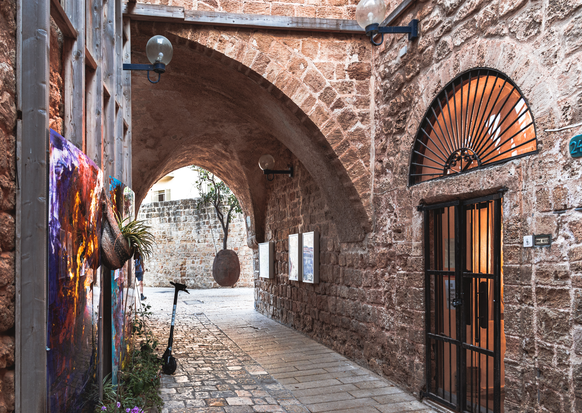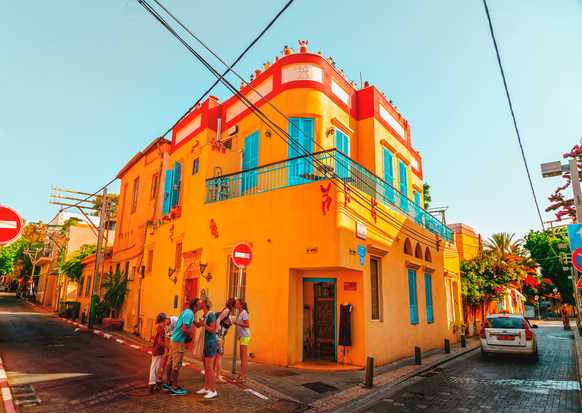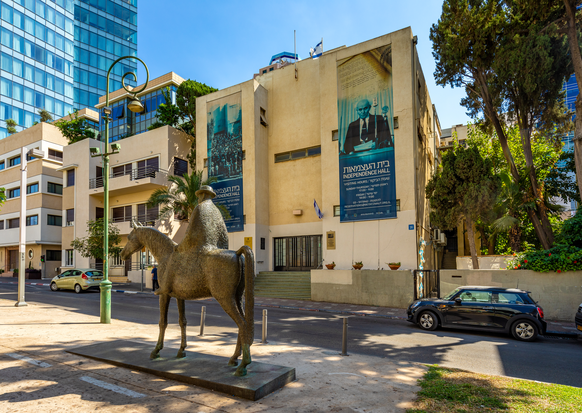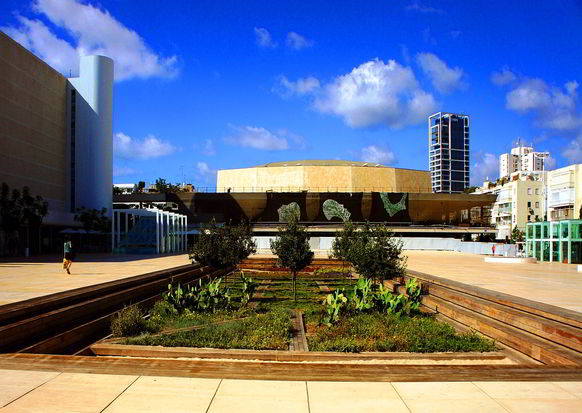Tel Aviv & Herzliya Attractions
The central area, Tel Aviv, Jaffa and Herzliya, is full of attractions and things to do with children, as a whole family, as a couple or alone.
The multi-faceted Tel Aviv is recognized as the cultural capital of Israel and contains some of the most famous points of interest in the Holy Land.
The Eretz Israel Museum, Jaffa Port, Tel Aviv seashores and a variety of fascinating places in the White City that will provide you with an adrenaline-filled urban vacation. On this page, we have a selection of the leading, most popular attractions to the special hidden gems for you to explore and be enchanted by the effervescent Tel Aviv.
Local Attractions

A Romantic Sunset Tour in Ancient Jaffa
We will take a tour through the magical alleys of the ancient city of Jaffa, view the Tel Aviv skyline and end the tour in the ancient port of one of the most beautiful cities in Israel.
Our tour begins in Jaffa Clock Square. After the fall of the city walls this square was a bustling market where you could find everything, from thread to a camel. On one side of the square stand the impressive ruins of what was the new government palace, Al-Saraya al-Jadida - the Saray, built in 1897. Most of the building collapsed in an explosion of a car bomb set off by the Lehi in 1948. On the other side you will see the impressive gate at the entrance to the Kishle complex, which served as the Turkish army camp in Jaffa until 1917, a British jailhouse and later the Kishle police, where the Israeli movie The Policeman was filmed. At the center of the square is a three-story tower built in honor of the 25th anniversary of the reign of Sultan Abdul Hamid the Second. The clock at the top of the tower was the first modern clock in the Land of Israel. We will continue from the tower and turn left into Beit Eshel Street which was the main street that led from Jaffa eastwards towards Jerusalem.
This street is the northern boundary of the flea market complex. We will pass by the famous Dr. Shakshuka restaurant and turn right on to Rabbi Pinchas Ben Meir Street and immediately left into one of the narrow streets of the market’s clothing bazaar. The market was established during the Ottoman period, has operated in this location since the 19th century and nowadays spans several streets. It is a bustling market all year round and a point of attraction for visitors, tourists and bargain hunters. Alongside antique objects and nostalgic items you will find restaurants, cafés and art galleries. The market is undergoing preservation and restoration in recent years, alongside urban renewal of the area. In the evening hours the market becomes a vibrant nightlife hotspot until the wee hours of the night.
We will leave the market through its main street, Olei Zion, and walk westward. On Yefet Street we will turn right and pass by the famous Abulafia Bakery which has operated here since the end of the 19th century. Now we will turn right on to Tayelet Mifraz Shlomo Street. Immediately on the right we will see a fountain. This magnificent public water fountain is known as the Sabil Mahmudiyeh (Sabil Suleiman). Built almost 200 years ago the fountain served those who came into and left the city of Jaffa and is directly opposite the gate to the city that remains standing. The gate is a relic of the city wall that stood here and was destroyed. We will continue on Tayelet Mifraz Moshe Street. On the left we will see an ancient structure, Al-Saraya al-Atika, Old Saraya House, which now houses the Arab-Hebrew Theater, the Old Jaffa Museum of Antiquities and the long-standing Hamam night club. In the past the building was home to the Damiani family soap factory. We will continue along the street, turn left and walk up the stairs leading to Hapisga Garden (Abraham Garden).
We will walk up the garden to the upper square with the stone sculpture, the Gate of Faith, created by Daniel Kafri. This is the highest point in Jaffa. We will look east towards the Judea and Samaria mountains and the city of Modiin, to the northeast we can see the Tel Aviv skyline in all its glory, and to the north the coastline up to Herzliya. Down the slope of the garden towards the west we will see St. Peter’s Church that overlooks the Mediterranean Sea and is located near Kedumim Square. The steeple of the church, that was built in the 19th century, became an iconic landmark of Old Jaffa. We will go down the steps into Ramses Garden, where the ruins of this Egyptian Pharaoh’s palace which once stood here were found.
We will make a wish while standing on the Wishing Bridge in the garden, and then get back off the bridge (not cross it to the other side) and continue along the paved path towards the south. On the left we will pass by a stone sculpture created by Andre Revesz, turn left and walk down the paved path. At the end of the garden on the south side there is a small parking lot (follow the sign in the direction of the Simta Theater). We will walk through the parking lot into a small street, Mazal Gdi (Capricorn) Street. After the renovation of old Jaffa in the 1960s the streets received the names of the zodiac signs. In this part of the tour we will pass through the narrow alleys that became the Artists’ Quarter. From Mazal Gdi Street we will glance left towards the end of the alley and the Floating Orange Tree sculpture. We will continue west on Mazal Arie (Leo) Street. We will pass by the shop and studio of the known artist Frank Meisler and next to a small metal gate through which Napoleon’s soldiers entered and conquered the city in 1799. From Mazal Arie Street we will turn right towards the steps that go up to Mazal Dagim (Pisces) Street and then turn left towards the west. This street has abundant galleries and is adorned with the works of the artists who live here. On the left we will pass by the Simta Theater and walk down to the end of the street and reach the Ilana Goor Museum. The museum exhibits her work as well as her collection of artwork from all over the world. The museum balcony offers a magnificent view towards the south and Jaffa Slope Park that borders sea and the picturesque Ajami neighborhood. Near the museum is an old synagogue that now serves those who came from Libya. In the 18th century the entire building served as the first Jewish Khan in Jaffa.
We will go down the steps, cross the paved way and walk down Simon the Tanner Alley. According to tradition St. Peter had a vision when he slept on the roof of Simon the Tanner’s house. We will continue down the steps, turn left and reach the port. Jaffa Port is one of the most ancient ports in the world, dating back thousands of year. The port is one of the important symbols of the city, served as the main entrance gate to the holy land, and throughout history was the country’s main lifeline.
We strongly recommend touring the port, looking in the direction of Andromeda’s Rock, walking along the huge warehouses the British built to store, among other things, the renowned Jaffa oranges. The location is now a marina and a small fisherman port, and is part of the long beach promenade that begins in north Tel Aviv and ends in Bat Yam. From the port you can take a short boat ride along the Tel Aviv coastline or sit at one of the fish restaurants or cafes and enjoy a wonderful sunset. After a tour of the port the beach promenade will lead you eastward back to Clock Square and the end of our tour.

Small Castles in the Sand – Hatachana Complex and Neve Tzedek
Neve Tzedek was the first Jewish neighborhood built outside the walls of old Jaffa in 1887. Intellectuals lived and worked in the neighborhood, among them Agnon, Brenner, Baron, Gutman and Azar, and alongside the first schools that taught in Hebrew created the foundation for the building of the new Jewish culture and identity in the Land of Israel. The stone houses with the red tile roofs earned Neve Tzedek the name “Small Paris” and were the most important catalyst for the establishment of the city of Tel Aviv, with some of its founders hailing from Neve Tzedek.
We will begin our tour in Clock Square in Jaffa. We recommend visiting Abulafia Bakery on 7 Yefet Street and choosing from among the large selection offered by this famous bakery which has operated since 1879! This was the main square of the city of Jaffa, with the clock tower of the Al-Saraya al-Jadida - the Old Saray building at its center. The building served as the city hall and the seat of the Ottoman government. Opposite it were the Ottoman army base and police complex, the Kishle, which is now a luxury hotel. We will turn left and walk north along the ocean on the beach promenade, passing by Gidi House, the Etzel Museum. We will turn right going east, cross the street and enter the Tahana (station) Complex. This was where the first train in the Land of Israel set out in 1892, connecting Jaffa and Jerusalem. In the complex you will see an old train carriage as well as Vila Weiland that belonged to the Templer Wieland family and their brick and tile factory. We will leave Hatachana Complex and cross the garden to Shabazi street. Shabazi is the main street that connects all the Jewish neighborhoods that were built here. This is now a Soho type street, lined with boutiques, stores, galleries and restaurants. We will turn into Hevrat Shas Street near Cafe Suzana. One of the oldest synagogues in the neighborhood still functions in this street.
From Hevrat Shas Street we will turn right on to Ein Yaakov Street. The building on 14 Ein Yaakov Street served as the first school in the neighborhood. We will enter the long passageway into the inner yard. In the yard there are remains of a water well. The school classrooms were on the bottom floor and the teachers and their families lived on the second floor. We will leave through gate that turns towards Chelouche street, turn right and advance until we reach Shabazi Street where we will turn right again, and after 100 meters turn left and reach the Suzanne Dellal Centre for Dance and Theatre. In the large plaza stand two buildings of the two renowned schools in the neighborhood: Alliance School for Boys and the Hovevei Zion School for Girls. The complex was renovated in the 1980s to become the Centre for Dance and Theatre, which is home to both the Batsheva Dance Company and the Inbal Dance Theater.
Notice the colorful mural wall at the edge of the plaza created by the artist David Tartakover which depicts the history of the Neve Tzedek neighborhood and its founders Shimon Rokach and Aharon Chelouche. We will enter Yehieli alley and turn right on to Chelouche Street. On the left you can see the beginning of Stein Street and up Chelouche Street the beginning of Rokach Street. These three streets make up the original Neve Tzedek neighborhood that was built in 1948. Further down, beyond the metal gate in the wall, we can see the Chelouche family house. The family came from Morocco and settled in Jaffa where Aharon became the leader of the Mizrahi community in the city.
Next to the family house is the Chelouche synagogue. In the holy ark is the oldest Torah scroll in Tel Aviv which the Chelouche family brought with them when they came to the Land of Israel. We will continue along Chelouche Street and stand on the bridge overlooking the railroad track. From the bridge you can see the Mesila (track) Park, that spans from Hatachana Complex near the coastline to the west up to Herzl Street to the east, as well the old Templer neighborhood and community. We will get off the bridge and return to Chelouche Street, and at the corner turn right on to Rokach Street and pass by the Abulafia family house. We will walk east along Rokach Street and stop near the Nahum Gutman Museum. This is a small museum showcasing Gutman’s artistic activity. In this building that now houses the museum lived the writers Dvora Baron and her husband Yosef Aharonovich as well as the renowned writer Yosef Haim Brenner who was murdered here in the riots of 1921. Together they published the Hebrew publication Hapoel Hatzair.
At the end of Rokach Street stands the home of Shimon Rokach. Over the years the building became a small and beautiful museum dedicated to the history of the family and the neighborhood, which Shimon founded together with Aharon Chelouche. We will leave Rokach Street and turn left on to Pines Street. We will stop at the corner of Pines and Lilienblum streets, where the two houses known as “the twin houses” of the Chelouche family still stand. However, the highlight of this corner in the neighborhood is the building of the renowned Eden Cinema, the first movie theater in the Land of Israel which opened in 1913. On the other side of the street is the kiosk that catered to the moviegoers. The kiosk became famous owing to the filming of the movie Eskimo Limon on this street. We will continue walking and on the left see the Aden community synagogue Kol Yehuda. The first floor houses the Aden Jewish Heritage Museum. The Tachkemoni School, which is now an ulpanit, school for religious girls, operated near the synagogue for many years. Near the school stands a beautiful structure, the Elkonin (Central) Hotel, that was built in 1913 and was the first hotel in Tel Aviv. The strict health regulations set at the time by the city physician of Tel Aviv, Dr. Chaim Hissin, stated that “for every five rooms, or ten people there must be a toilet”. Among the hotel guests was King Abdallah, who some say had an affair with the hotel owner’s daughter. We will turn left on to Yehoshua Hatalmi Street and after 100 meters turn right on to Rothschild Boulevard. This is the exact place where the city of Tel Aviv was born in 1909, but that’s a different story.

From the Independence Trail to Dizengoff Center – A Journey into the White City
Today we set out on a tour to the heart of Tel Aviv along Rothschild Boulevard. This street stretches from Herzl street in the west to White City Square (Orchestra Square). This is a journey to the cradle of the first Hebrew city that was founded in 1909. The boulevard was the backbone and symbol of the development of Tel Aviv from a small city to a bustling metropolitan. The great events which changed the face of the country took place here, in the heart of the boulevard.
We will begin our tour in the western lobby of the Shalom Tower which can be reached through gate number 1. The building is located on the corner of Herzl and Ahad Ha'Am streets. The entire lobby wall showcases the spectacular mosaic work of the artist Nahum Gutman who grew up on Herzl street nearby.
We will exit the building and stop near the house on the corner of Herzl and Ahad Ha'Am streets. This was the home of Akiva Arieh Weiss who conceived of the idea to establish the city of Tel Aviv and was its founder. The house is built of coarse sand and seashell bricks and is one of the only two remaining buildings from among the city’s first buildings. Overlooking the house is Shalom Tower that opened in 1966 on the site of the Herzliya Hebrew Gymnasium.
Notice the brass strip that will accompany us for part of the tour which marks the Independence Trail and runs along the sidewalks. The trail includes 10 numbered stops that tell the historical story of “little Tel Aviv” and the declaration of the State of Israel. We will walk along Independence Trail that goes around the building from the west, pass the statue of Alfred Dreyfus and reach a small square, Gutman Square. In the center of the square stands the spectacular Nahum Gutman mosaic fountain which describes the history of Tel Aviv and Jaffa.
We will merge into Rothschild Boulevard, walk eastwards and cross Herzl Street. This was the precise site where the famous photograph of the historic seashell ceremony was taken, in which plots of land were allotted to the city’s founders. To this day this is considered the photograph which immortalizes the moment the city was born.
This is also where the city’s first street light stood, as well as the city’s mythological kiosk that was reconstructed in the 1980s. You are invited to drink a glass of “gazoz” at the kiosk for a taste of little Tel Aviv of days gone by. We will continue along Rothschild Boulevard and pass by the municipal information office – an opportunity to check out what’s going on in the city and receive information about the trail and its stops.
The most important building along Independence Trail is of course Independence Hall which is located at 16 Rothschild Boulevard. This house, one of the city’s first buildings, served as the residence of Tel Aviv’s first mayor, Meir Dizengoff, and his wife Zina. After his wife’s death Dizengoff donated the house which became the city’s first art museum in the 1930s. The museum building was chosen as the site of the Declaration of Independence ceremony which took place on Friday, May 14, 1948. And thus the State was born. Don’t miss a visit to the Hall.
We will continue our journey along the boulevard and pass by the Founders Monument on which the names of the city’s founders are inscribed. The water pool and fountain commemorate the site of the city’s first water tower. We will stop opposite 23 Rothschild Boulevard which was the home of Moshe Sharet, Israel’s second Prime Minister. This was also the residence of Eliyahu Golomb, the founder and commander of the Haganah. The building now houses the Haganah Museum. We will continue along Rothschild Boulevard and at the corner of Allenby Street turn our gaze to two eclectic buildings, on the right Ginusar Hotel and on the left Lederberg House, examples of the spectacular eclectic architectural style which dominated the city in the 1920s. Here we recommend turning left on to Allenby Street and walking along Independence Trail northwards until you reach the Great Synagogue of Tel Aviv. Visit the building to experience the beauty and splendor of the synagogue, a place of worship since 1925.
From the Great Synagogue we will return to Rothschild Boulevard and walk east. The Levin House on 46 Rothschild Street, which underwent amazing preservation, was a private residence and also housed the Russian Embassy. We recommend turning into Shadal Street to visit the Sephardic synagogue at its center.
We now enter the heart of the White City. This is markedly evident next to the kiosk on the corner of Rothschild Boulevard and Nahmani Street. Right next to the crosswalk notice the bronze plate set in the boulevard sidewalk. The plate marks the declaration of the White City as a UNESCO World Cultural Heritage site in 2003.
The two kiosks in this part of the boulevard offer a wonderful opportunity to take a coffee break.
With a cup of coffee in hand turn your gaze to the buildings on 82 and 84 Rothschild Boulevard, the Rubinsky & Braun House and the Engel House, among the most prominent buildings built in the city in the 1930s. The Engel House, on 84 Rothschild Boulevard, was designed by the renowned architect Ze’ev Rechter and was the first building in the city to be built on pillars.
Pause for a minute at the intersection of Rothschild Boulevard and Shenkin Street. You can get off the trail on Shenkin Street and connect to the Carmel Market. We will continue walking along the Boulevard and reach Orchestra Square which is known as Habima Square.
The square was part of a Templar agricultural farm, then a study garden for school pupils, and ultimately the parking garage for Heichal Hatarbut - Charles Bronfman Auditorium and Habima theater. In 2017 the square got a new look after comprehensive renovation planned by the sculptor and artist Dani Karavan. A garden of pear trees and sabra cactus bushes was planted in the center of the square, encompassed by long wooden benches and soft classical music. The square is located on a main city route and connects several traffic arteries, yet it is not noisy. Heichal Hatarbut is found on one side of the square and Habima theater on the other side. We will cross the square in the direction of Heichal Hatarbut and walk through Yaakov Garden that was built on a hill, between the Habima theater and Heichal Hatarbut buildings. The original plan was to build the Tel Aviv Museum on this hill, which is why the Helena Rubinstein Pavilion was built nearby. However, in order to preserve the ancient Sycamore trees it was decided to build the museum somewhere else in the city.
Crossing the square we will reach the corner of Dizengoff Street and Chen Boulevard where our tour ends. You are now invited to turn left and walk down Dizengoff Street straight into the warm embrace of Dizengoff Center, the perfect ending for this very Tel Avivian tour.

From Habima Square – to Kerem Hateimanim Market Square and Carmel Market
Today we will tour the bustling heart of Tel Aviv. This is a “classic urban tour” of the city that combines history, an exhilarating urban experience in the vibrant city center, a visit to the famous Carmel market and the quaint alleys of the Kerem Hateimanim neighborhood, and the perfect finale on the Tel Aviv beach promenade.
Our tour starts at Orchestra Square, known as Habima Square.
The square was part of a Templer agricultural farm, then a study garden for school pupils and ultimately the parking garage of Heichal Hatarbut - Charles Bronfman Auditorium and Habima theater. In 2017 the square got a new look after wide-ranging renovation planned by the sculptor and artist Dani Karavan. Heichal Hatarbut is found on one side of the square and Habima Theater on the other side. The Yaakov Garden was built on a hill between the Habima Theater and Heichal Hatarbut buildings. The original plan was to build the Tel Aviv Museum on this hill, which is why the Helena Rubinstein Pavilion was built nearby. However, to preserve the ancient Sycamore trees it was decided to build the Museum somewhere else in the city.
From the front of Habima Theater building we will walk along Ben Zion Boulevard towards King George Street and turn left. The tall building on this street is Jabotinsky House located at the corner of Sheva Shikmim (seven Sycamores) Street. The street’s name stems from the ancient Sycamore trees at the center of this street, on the ancient route that passed here. The Etzel Museum is found on the ground floor of the building which serves as the headquarters of the Herut Movement,
We will pass under the shade of the Sycamore trees and see Meir Park on our right. Established in 1944, Meir (Dizengoff) Park was the first municipal park in the city of Tel Aviv. We recommend entering the park for a short visit, to stroll along the garden paths where you will find a beautiful ecological pond, a large playground, sport facilities and sport activities. The park is also home to the Municipal LGBTQ Center and near it stands the monument in memory of LGBTQ victims murdered in the Holocaust.
We will leave the park and continue west on King George Street, turning left into Plonit Alley, which is part of a tiny neighborhood built here in the beginning of the 1920s by the Jewish entrepreneur Avraham Getzel Shapira. We will enter the alley through the two stone obelisks at its entrance. At the end of the alley is the eclectic house of Shapira and his wife Sonya. In front of the building is a large stone sculpture of a lion, which some say Shapira placed there to protect his beautiful wife.
We will leave the alley and cross the street directly into Bezalel Market. The market was established in the 1920s and is mainly famous for the surplus luxury brand items at low prices that can be found here. Spend some time browsing through the different stores, and with a little bit of patience you just may find some bargains.
We will return to King George Street and reach the most bustling and familiar intersection in Tel Aviv, known by the name of Magen David Square owing to the six streets radiating out from the square, the same number as the six-pointed Star of David. The square is considered the busiest location in the city and is a point of attraction for many tourists and visitors. Don’t miss the attraction of the changing of the traffic light, when hundreds of people cross the intersection from all directions at the same time. The square gained its historical prominence during the 29 of November 1947 celebrations which took place in the buildings around the square. The buildings are an example of the convergence of eclectic and international style (Bauhaus) architecture.
In recent years the square became home to street singers, the most prominent among them is Miri Aloni who comes to sing in the square on Fridays and has already become a regular attraction. On Tuesdays and Fridays you will find an artist fair in the Nahalat Binyamin Pedestrian Mall. This is the largest and most long-standing fair of its kind in Israel and among the most picturesque and regarded in the world. The fair with its hundreds of stands has operated since 1988 and is open year round.
We will enter the Carmel Market’s main street, Carmel Street. This is the city’s main market and the largest and most renowned in metropolitan Tel Aviv. It officially opened in 1920, and over the years grew and expanded on the one side to Nahalat Binyamin Pedestrian Mall and on the other side to the Kerem Hateimanim (Vineyard of the Yemenites) neighborhood which borders it to the north. On Gedera Street for example you will find numerous food shops and restaurants. Over time it changed from a sleepy neighborhood that was established even before the city of Tel Aviv as a Jewish suburb of Jaffa to become part of the market’s expansive happening, mainly in the culinary field. Numerous restaurants were opened in the market and their tables are spread along the narrow alleys, creating a unique atmosphere and experience. A visit to one of the restaurants, most of them serving authentic Yemini food and managed by the neighborhood locals, is highly recommended. Take time to stroll through the market, to enjoy, and mainly to savor the myriad stores, restaurants, snack bars and stands. The market is undergoing a major transformation in recent years, similar to the change which took place in the Mahane Yehuda Market in Jerusalem, from a declining fruit and vegetable market to a modern vibrant tourist market.
The way out of the market will lead you directly to the market parking area and to the Hakovshim Garden with a monument at its center in memory of the defenders of Tel Aviv and the liberators of Jaffa. Cross the garden towards the ocean near the picturesque Hassan Bek Mosque and reach the city’s famous beach promenade. Tel Aviv’s 14-kilometer coastal strip stretches from Herzliya in the north to Bat Yam in the south. The promenade was upgraded in recent years and now offers long wooden decks that create shaded sitting areas right on the beachfront.
You are invited to stroll along the promenade and stop at one of the cafés or restaurants overlooking the sea, or perhaps rent a lounge chair and a beach umbrella, relax on the warm sand and end the day watching the sun setting into the Mediterranean Sea.
We recommend to take a taxi from the airport.
Distance
Dan Tel Aviv - 26 Km
Dan Panorama Tel Aviv - 24 Km
Link Hotel & Hub - 26 Km
Dan Accadia Herzliya - 37 Km
Buses and public transport are available.


